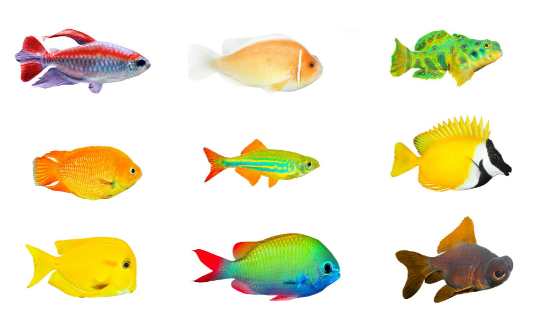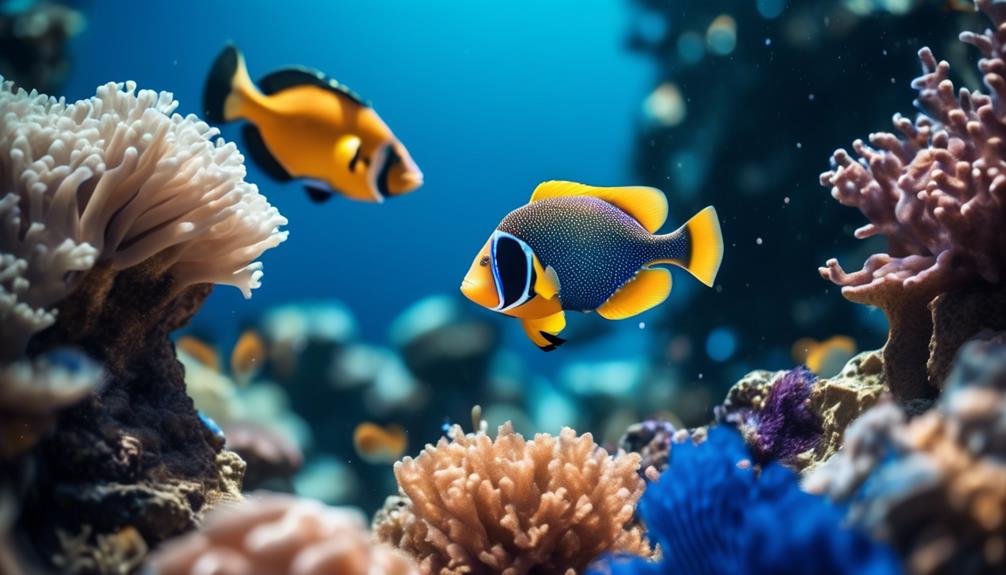
As you dip your toes into the vast ocean of marine life, one creature stands out amongst the rest, beckoning you to explore its enigmatic world. The triggerfish, with its alluring beauty and fierce demeanor, holds secrets waiting to be unraveled.
From their intricate patterns to their captivating behaviors, these fascinating creatures have captivated the hearts of aquarists and enthusiasts alike. But what lies beneath the surface? What mysteries await those who dare to venture into the realm of triggerfish?
Join us on a journey that will leave you fascinated and eager for more as we delve into the wondrous world of triggerfish and unravel the complexities that make them so fascinating and feisty.
Key Takeaways
- Triggerfish are a diverse family of marine fish with approximately 40 distinct species.
- They are large, aggressive fish that require a very large aquarium for proper care.
- Triggerfish are known for their beautiful colors and complex patterns.
- They are intelligent and highly territorial, making them best suited to be kept as individual specimens.
General Information About Triggerfish
Triggerfish, a family of marine fish comprised of approximately 40 distinct species, can be found in the tropical and sub-tropical oceans across the world. These fish are large in size and have an aggressive temperament. If you plan on keeping triggerfish in an aquarium, be prepared to provide them with a very large tank, around 200 gallons.
Triggerfish have rhomboid shaped, laterally compressed bodies and large heads. They’ve a unique defense mechanism consisting of two dorsal spines that lock into place for protection. When swimming, triggerfish primarily use an undulating motion of their dorsal and anal fins. These fascinating creatures come in shades of orange, yellow, purple, silver, grey, black, and white, displaying complex patterns and markings on their bodies.
Saltwater Habitat of Triggerfish
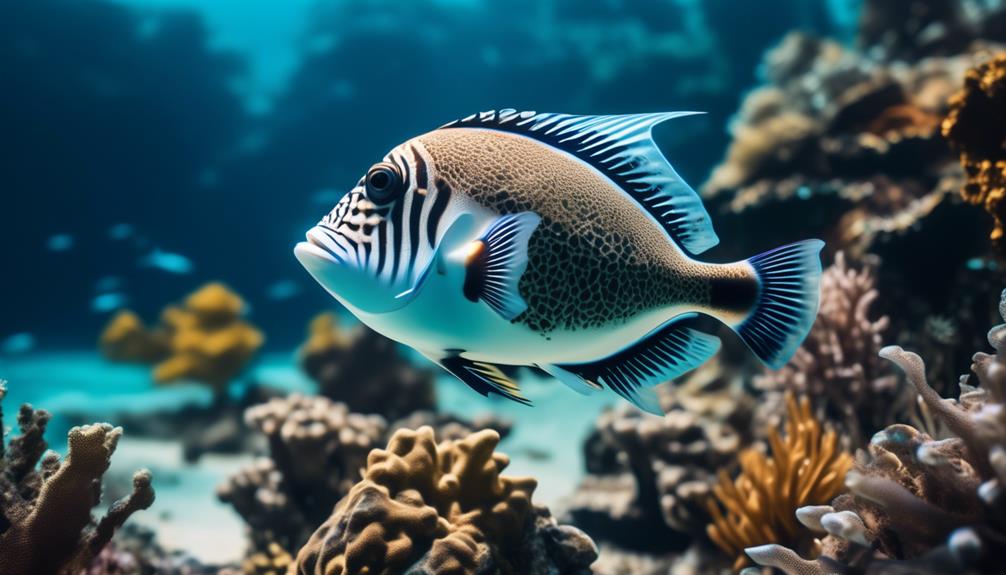
Triggerfish thrive in the saltwater habitats of tropical and sub-tropical oceans around the world. They’re well-suited to these environments due to their unique adaptations and behaviors.
Here are some key aspects of their saltwater habitat:
- Coral Reefs: Triggerfish can be found in and around coral reefs, where they seek shelter and feed on small invertebrates.
- Rocky Areas: They also inhabit rocky areas, using crevices and caves for protection.
- Coastal Waters: Triggerfish can be found near the coastlines, where they feed on crustaceans and other prey.
- Seagrass Beds: These fish are often found in seagrass beds, where they forage for food and find protection.
In these diverse saltwater habitats, triggerfish display their fascinating behaviors and adaptability, making them a captivating species to observe.
Size and Temperament of Triggerfish
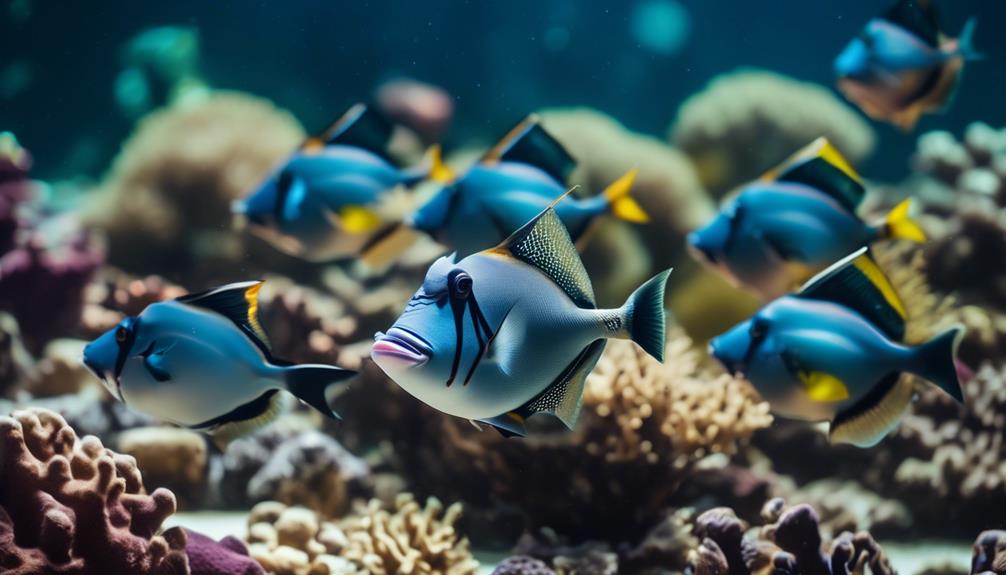
With their large size and aggressive temperament, triggerfish are captivating creatures that require careful consideration in aquarium care. Triggerfish can grow quite large, with some species reaching lengths of up to three feet. Their robust bodies and powerful jaws make them formidable predators in the wild.
When it comes to temperament, triggerfish are known for their territorial and aggressive nature. They can become highly aggressive towards other tank mates, making it important to house them with caution. It’s recommended to keep triggerfish as individual specimens in a very large aquarium to minimize conflicts.
Due to their size and temperament, triggerfish are best suited for experienced aquarists who can provide them with the proper care and attention they need.
Aquarium Requirements for Triggerfish
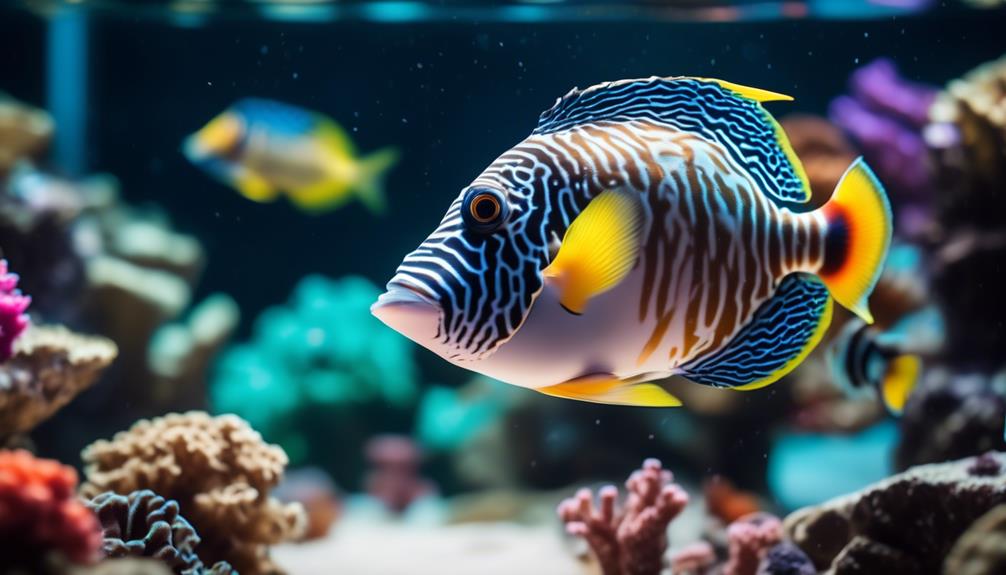
To properly care for triggerfish in an aquarium, it’s important to understand their specific requirements and create an environment that meets their needs.
- Tank Size: Triggerfish require a very large aquarium, with a minimum capacity of 200 gallons.
- Water Parameters: Maintain a stable water temperature between 74-82°F and a salinity level of 1.020-1.025.
- Tank Decor: Provide plenty of hiding spots with live rock, caves, and crevices to mimic their natural habitat.
- Tank Mates: Choose tank mates carefully, as triggerfish can be aggressive towards other fish and invertebrates.
Creating a suitable habitat for triggerfish is essential for their well-being. Make sure you have a spacious tank, maintain proper water parameters, and provide suitable tank decor.
Additionally, carefully select compatible tank mates to avoid any aggression issues. By meeting these requirements, you can ensure a healthy and thriving environment for your triggerfish.
Physical Characteristics of Triggerfish
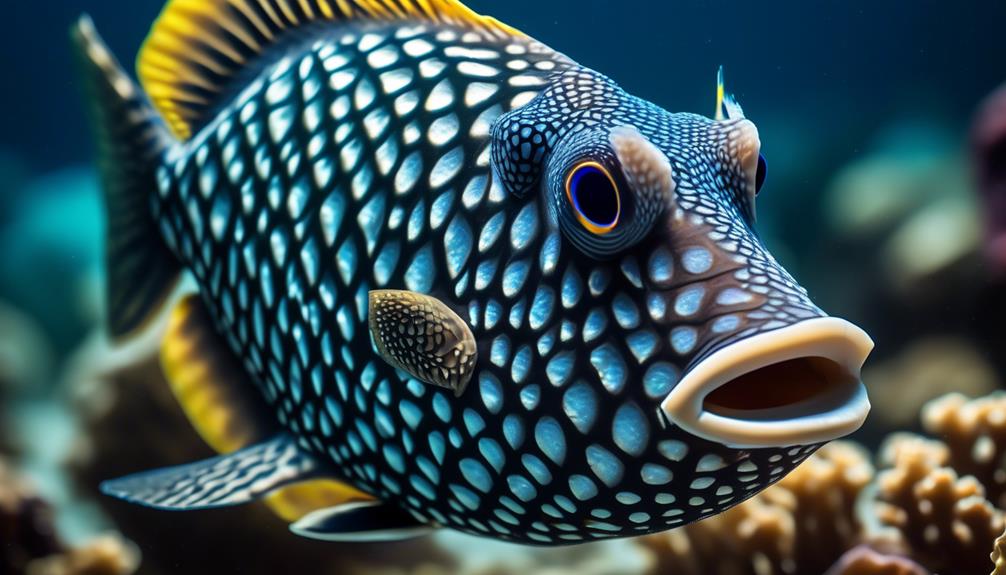
One fascinating aspect to explore when it comes to triggerfish is their physical characteristics. Triggerfish have rhomboid shaped, laterally compressed bodies and large heads. They are large in size and can grow up to several feet long. Most species of triggerfish have complex patterns and markings on their bodies, which adds to their beauty. They come in a variety of vibrant colors including shades of orange, yellow, purple, silver, grey, black, and white. Triggerfish have two dorsal spines that can lock into place for protection, serving as a defense mechanism. They swim primarily using an undulating motion of their dorsal and anal fins. Overall, triggerfish are known for their unique physical features and stunning appearance.
| Physical Characteristics |
|---|
| Large size |
| Rhomboid shape |
| Complex patterns |
| Vibrant colors |
| Two dorsal spines |
Defense Mechanism of Triggerfish
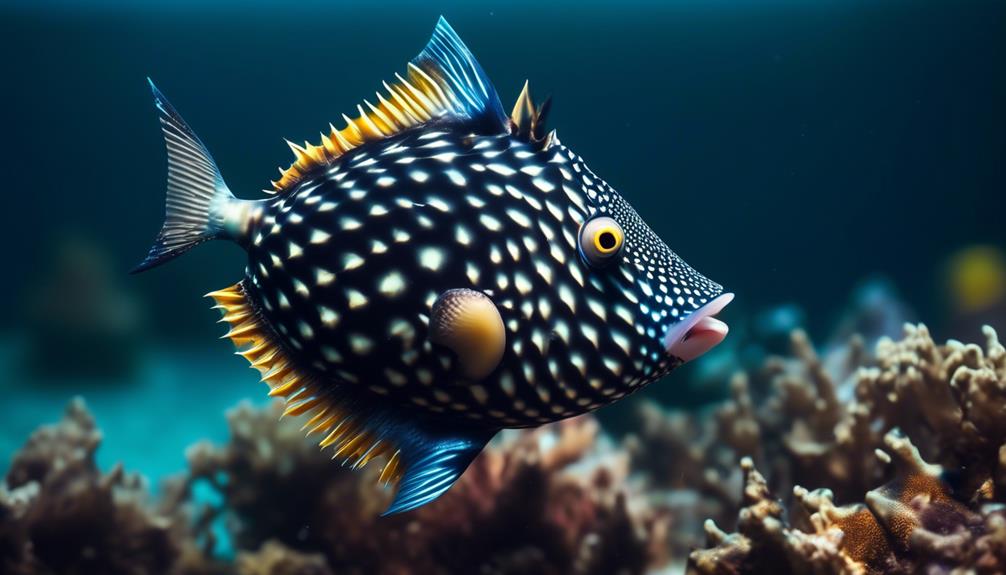
Triggerfish employ a unique defense mechanism involving their dorsal spines, which play a crucial role in protecting them from potential threats. Here are some key points about their defense mechanism:
- Dorsal Spines: Triggerfish have two dorsal spines that can be locked into place when they feel threatened.
- Locking Mechanism: These spines can be raised and locked, making it difficult for predators to swallow them.
- Sharp Spines: The dorsal spines are sharp and rigid, acting as a deterrent to potential predators.
- Powerful Bite: Triggerfish also have powerful jaws and teeth, which they can use to defend themselves if necessary.
Swimming Motion of Triggerfish
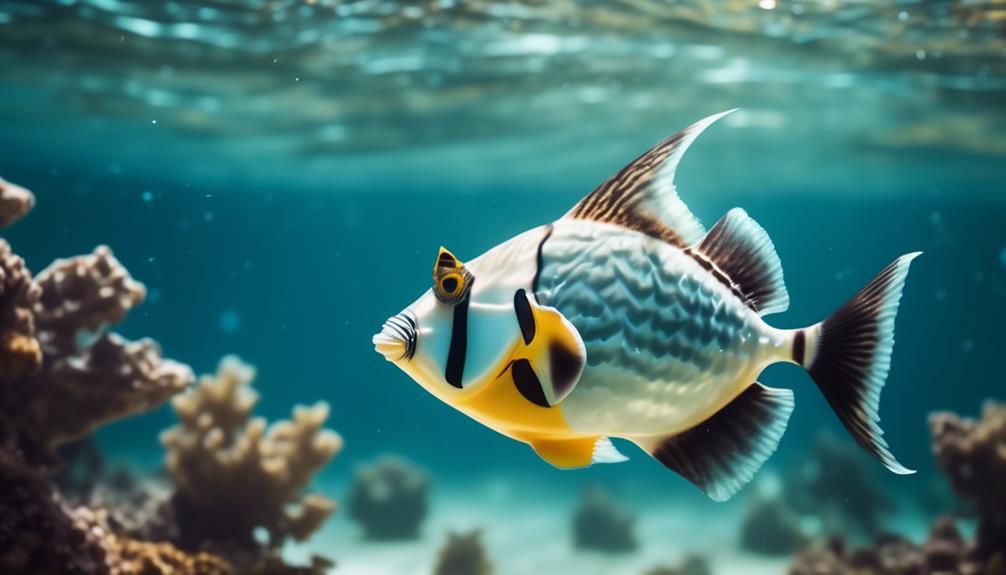
After understanding the defense mechanism of triggerfish, it’s fascinating to explore their unique swimming motion.
Triggerfish swim primarily using an undulating motion of their dorsal and anal fins. This motion allows them to move through the water with precision and agility. As they swim, their large, rhomboid-shaped bodies glide effortlessly through the currents.
The undulations of their fins create a graceful and rhythmic movement, propelling them forward with ease. It’s truly mesmerizing to watch a triggerfish navigate its environment using this distinctive swimming technique.
Whether they’re darting through coral reefs or gracefully gliding in open waters, triggerfish exhibit a swimming motion that’s both captivating and efficient. Their ability to adapt and maneuver through various aquatic environments is a testament to their evolutionary success.
Beauty and Fascination of Triggerfish
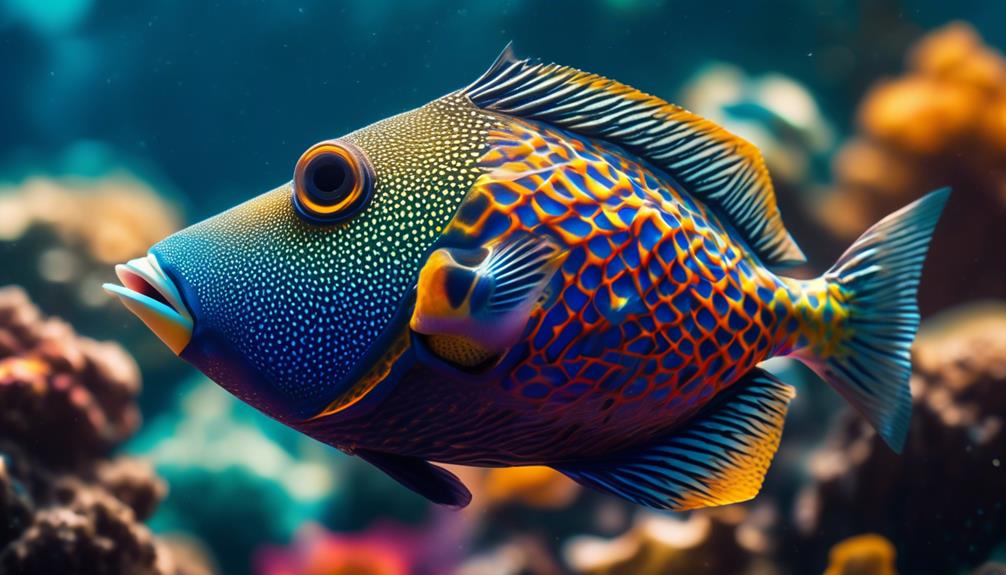
With their vibrant colors, intricate patterns, and distinctive personalities, triggerfish are truly captivating creatures of the sea. Their beauty and fascination can be attributed to several factors:
- Dazzling Colors: Triggerfish come in a wide array of shades including orange, yellow, purple, silver, grey, black, and white, adding a stunning splash of color to any aquarium.
- Complex Patterns: Most species of triggerfish boast intricate patterns and markings on their bodies, making them visually striking and unique.
- Variety: From the popular Clown Triggerfish to the Bursa Triggerfish and Niger Triggerfish, there are numerous species to choose from, each with its own captivating features.
- Unique Personalities: Triggerfish exhibit individual personalities, often displaying curious and feisty behavior that keeps aquarium enthusiasts fascinated.
These captivating attributes make triggerfish a prized addition to any marine collection, as they bring both beauty and intrigue to the underwater world.
Experience Required for Triggerfish Care
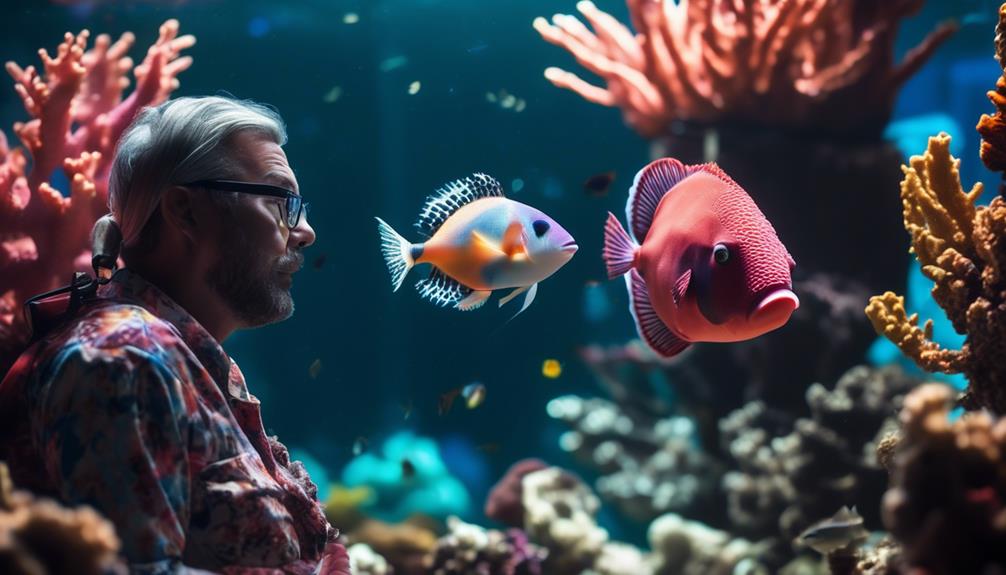
To properly care for triggerfish, it’s essential to have prior experience and knowledge in handling these intelligent and territorial creatures of the sea. Triggerfish aren’t your typical aquarium fish; they require a high level of expertise and understanding to thrive in a captive environment.
Their aggressive temperament and territorial nature make them challenging to keep, especially in a community tank. Triggerfish need a very large aquarium, at least 200 gallons, to provide enough space for them to swim and establish their territories.
Additionally, they’ve a unique diet consisting of crustaceans, shrimp, earthworms, octopus, and squid, which must be carefully balanced to meet their nutritional needs. Furthermore, triggerfish can be destructive to aquarium decor and equipment with their powerful teeth, so careful consideration must be given to tank setup.
Color and Varieties of Triggerfish
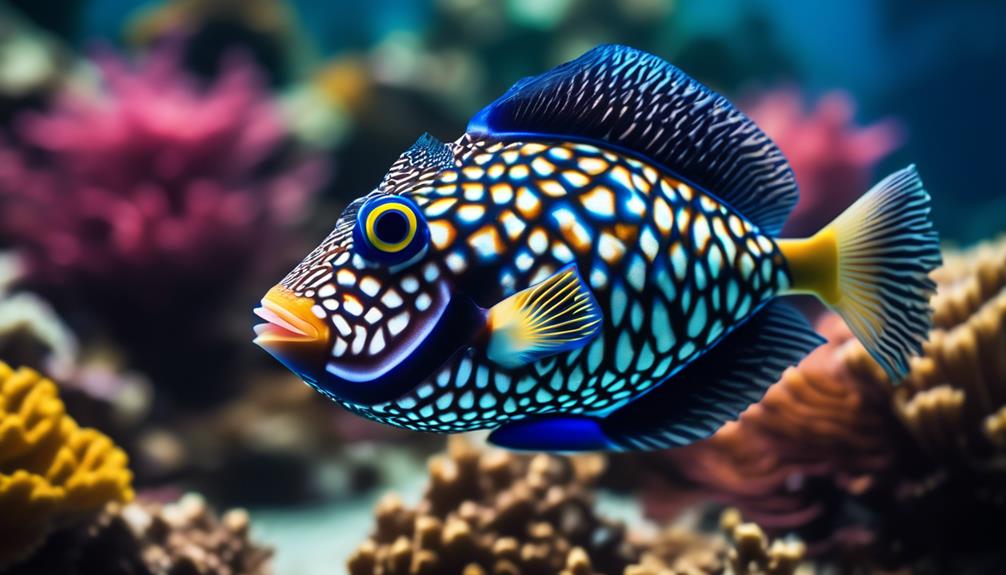
Triggerfish come in a stunning array of colors, ranging from vibrant oranges and yellows to deep purples and silvers. They’re known for their vibrant colors and complex patterns. Some popular triggerfish varieties include Clown Triggerfish, Bursa Triggerfish, and Niger Triggerfish. Each individual triggerfish specimen often displays a highly unique personality. These beautiful fish are a sight to behold in any aquarium.
- Triggerfish come in shades of orange, yellow, purple, silver, grey, black, and white.
- Most species of triggerfish have complex patterns and markings on their bodies.
- Some popular triggerfish varieties include Clown Triggerfish, Bursa Triggerfish, and Niger Triggerfish.
- Individual triggerfish specimens often display highly unique personalities.
Maintenance and Care Tips for Triggerfish
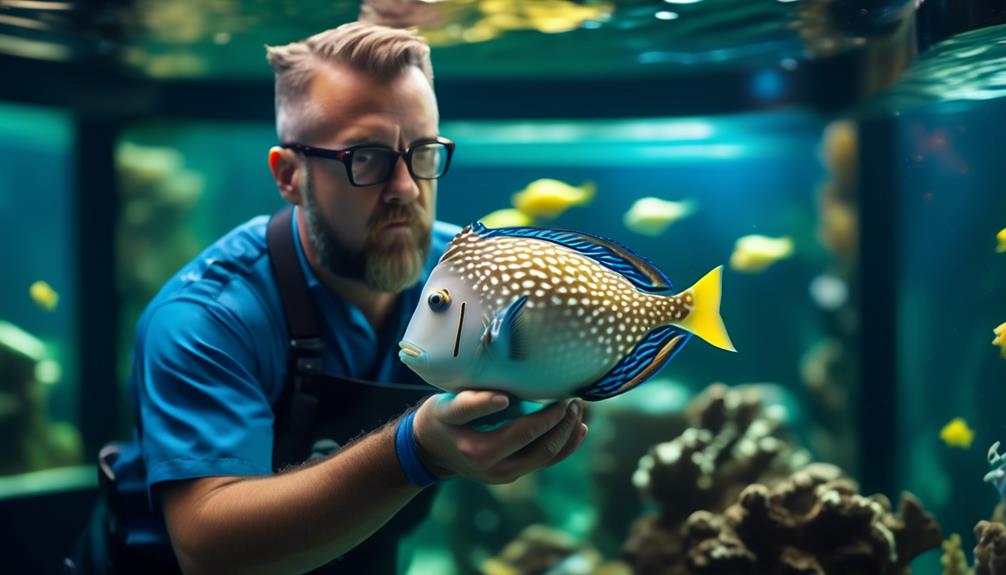
Now let’s shift our focus to the essential maintenance and care tips that will ensure the well-being of your triggerfish. Triggerfish are intelligent and highly territorial fish, so it is best to keep them as individual specimens in a large aquarium. They can be aggressive towards other tank mates, so choose their companions carefully. Triggerfish should be fed a varied diet of crustaceans, shrimp, earthworms, octopus, and squid to meet their nutritional needs. Be cautious with aquarium decor and equipment, as triggerfish have powerful teeth that can damage them. While breeding triggerfish in an aquarium environment is challenging, they are hardy and can thrive with proper care. Regular weekly care and attention are necessary for their well-being.
| Care Tips for Triggerfish |
|---|
| Keep as individual specimens |
| Choose tank mates carefully |
| Provide varied diet |
| Be cautious with decor and equipment |
| Regular weekly care |
Frequently Asked Questions
Can Triggerfish Be Kept in a Small Aquarium?
No, triggerfish cannot be kept in a small aquarium. They require a very large aquarium, ideally around 200 gallons, due to their large size and aggressive temperament.
How Long Do Triggerfish Live in Captivity?
Triggerfish can live up to 10-15 years in captivity. However, their lifespan depends on various factors like tank conditions, diet, and overall care. Providing a suitable environment is crucial for their longevity.
Are There Any Triggerfish Species That Are Suitable for Beginners?
Yes, there are triggerfish species that are suitable for beginners. They require a large tank, proper care, and a varied diet. However, it’s important to consult with an experienced aquarist for guidance.
Can Triggerfish Be Trained to Perform Tricks?
No, triggerfish cannot be trained to perform tricks. They are highly intelligent, but their aggressive nature and territorial behavior make it difficult to train them in the same way as other species of fish.
What Is the Most Challenging Aspect of Caring for Triggerfish?
The most challenging aspect of caring for triggerfish is their aggression and territorial behavior. You’ll need to keep them as individual specimens and carefully monitor their interactions with other tank mates.
What Are the Similarities and Differences Between Triggerfish and Butterflyfish in terms of behavior and habitat?
The unveiling the world of butterflyfish reveals that both triggerfish and butterflyfish display territorial behavior. However, triggerfish are known to aggressively defend their territory, while butterflyfish are less aggressive. In terms of habitat, both can be found in coral reefs, but triggerfish are also found in rocky shores and sandy areas.
Conclusion
In conclusion, triggerfish are truly captivating creatures with their vibrant colors and feisty personalities. Caring for them in an aquarium setting requires experience and knowledge, as they’ve specific requirements and territorial behavior.
Their physical characteristics and intricate patterns make them a beautiful addition to any marine fish collection. However, it’s important to remember that triggerfish can be challenging to care for and may not be suitable for beginners.
With proper maintenance and care, these fascinating fish will continue to amaze and delight enthusiasts of marine life.




